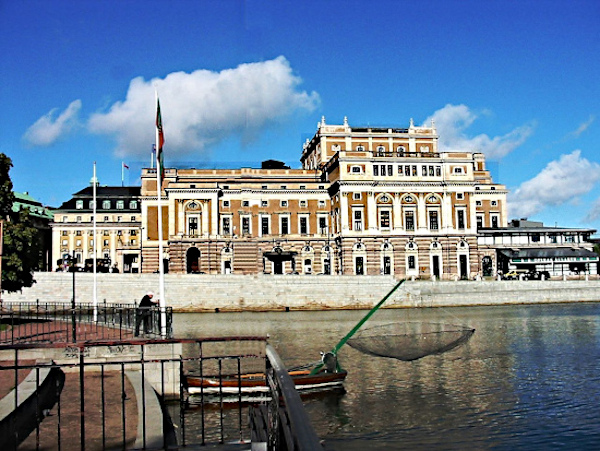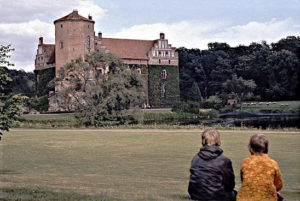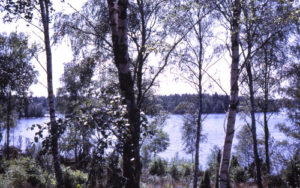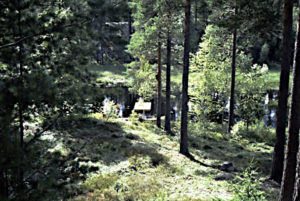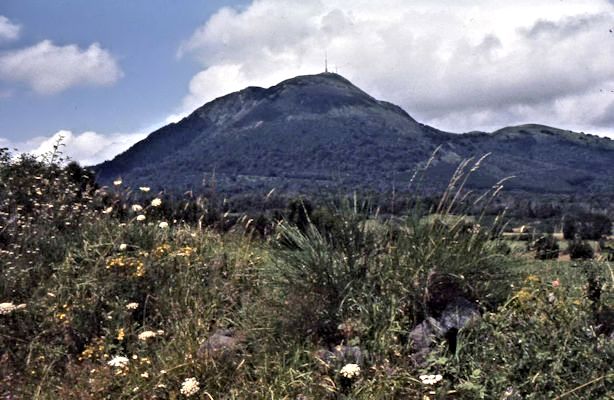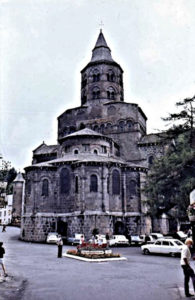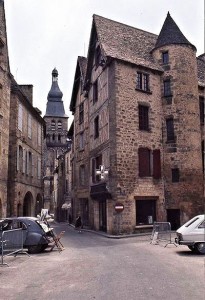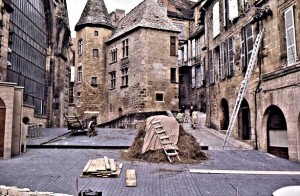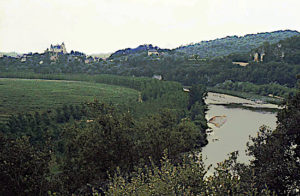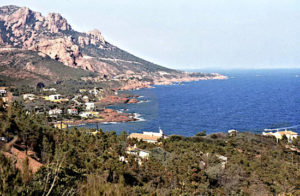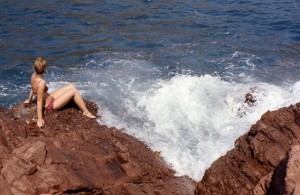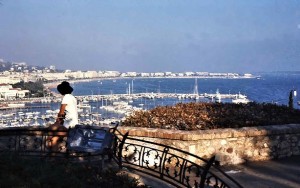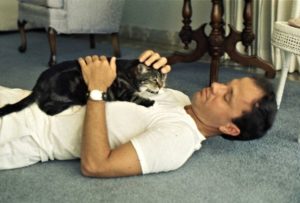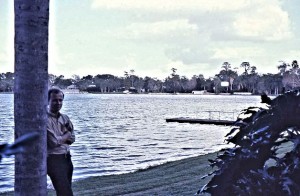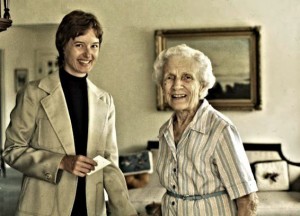Chapter 21 (Part 1) – Travels with John in the summer of ’71
That very same summer of 1971 we visited Sweden and John got to know some of my country, my family and quite a few of my friends.
It started out by my driving my little secondhand Renault 4L alone through Belgium and Germany. I made a break in Köln (Cologne), and the next day i drove on to Wilhelmshaven where my old buddy from Lund, Albrecht Eiselt and wife Angela, were waiting for me with their children.
I knew Angela too, slightly, from the stop on the bus tour around Europe in 1966. Tthey were both waiting for me when our bus stopped in Köln, coming from Paris. Now, after two days with Albrecht and Angela, I went on to Lübeck and Travemünde, where I took the ferry to Trelleborg.
Back to traveling northwards in Sweden with John. First of all we made a very memorable stop in Lund with Gun and Per, and John got to know my sister and her family — and of course also a bit of Skåne, the southernmost province in Sweden where I grew up. Brother-in-law Per is an excellent guide of his beautiful Skåne. John loved it, and so did I.
We made a tour of the southwest, stopping at Torup slott (château) dating from the 16th century. It is located in what is call Bokskogen (the beech forest) and I remember well how, during the war, we would ride our bikes to Bokskogen, along with a hoard of other Sunday bikers. During the war we did not have a car because of the gasoline rationing. Mother sold her car when we would have needed an aggregate for burning coal to make producer gas. If, however, you needed a car for professional use, you got a license to run your car with gasoline. But for us it was bicycles.
ngg_shortcode_0_placeholder” order_by=”sortorder” order_direction=”ASC” returns=”included” maximum_entity_count=”500″]After a few wonderful days in Lund and environs, we waved goodbye to my family and traveled in my little Renault 4L to Mother’s country house in southern Småland, given to her by my grandparents. It is situated in a gorgeous region of Småland with vast forests and lakes.
We went swimming with Arne in the beautiful lake Mien where the water is so clean you can drink it.
Arne was the main cook that evening, and he had prepared his favorite dish which was sweetbreads (kalvbräss), always called ris de veau by us. Mother had prepared a Swedish specialty, freshly dug up potatoes, boiled with lots of dill and usually eaten with butter. Those potatoes are a delicacy all by themselves.
The very best way of eating Swedish new potatoes though is with sour cream, chives and salted herring — just salted, no sugar like in matje herring, which is something totally different. The herring has been salted in barrels for several days. However, this old-fashioned delicacy is getting ever more rare in Sweden. In Norway and Iceland I do believe you can still get it. The herring is put in salt in the barrels out at sea. You usually have to desalt it in water for a few hours before eating it.
ngg_shortcode_1_placeholder” order_by=”sortorder” order_direction=”ASC” returns=”included” maximum_entity_count=”500″]But this wasn’t salt herring, it was about ris de veau. Arne, who is quite a gourmet cook and liked to try new things, had also made a sauce hollandaise with great success and there was also broccoli.
We sat down to eat this delicious meal. But John was a bit flustered at this first meeting with my parents, so he happened to put the sauce hollandaise on the ris de veau. Arne noticed it immediately and told him in a school teacher’s tone of voice “The sauce hollandaise is for the broccoli.” John, also a true gourmet, will never forget this and his embarrassment and it has become a never-dying joke between us. Since then we have had many wonderful meals with Arne in Paris, in restaurants and at our home. Arne and John got along wonderfully well.
Our odyssey went on to Stockholm this first time, since I have friends there. We were staying with Britt and Ingvar in Täby — just one time out of several times we have been staying at their beautiful house. We have even spent two Christmases with them. Wonderfully generous friends.
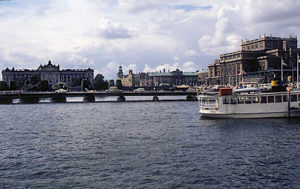
“Strömmen” is the narrowest part of Lake Mälaren. Riksdagshuset (the Parliament) in the background; the Opera on the right.
However, Stockholm is by no means to be missed. It is a wonderfully beautiful city, that sits on several islands on Lake Mälaren. That is, mainly the Old Town and quite a few other islands, but of course the larger parts of the city are on the mainland north and south of the lake. (More about Stockholm in Chapter 24 (Part 2) –– Stockholm and some history.)
In the photo here is Strömbron, one of the two bridges that connect the island of the Old Town with the mainland in the north, Norrmalm.
We walked and walked and walked through the streets of this wonderful Swedish capital. And of course we traveled by metro, and by bus out on Djurgården. Today, in 2021, there is even a streetcar that goes out on the island of Djurgården.
We loved Gamla stan (the Old Town), among other beautiful sites in Stockholm, and we had the most expensive dry martinis ever at the Grand Hotel on Blasieholmskajen. Quite ridiculous. What silly tourists we were. And yet Stockholm was my home for four years around 1960.
Stockholm may well be the most beautiful city in the world with its many islands on Lake Mälaren — water water everywhere — and its many beautiful old buildings, but what it lacks is the charm of the Paris cafés or the unpretentious but pleasant little bars of New York City.
We had dinner at Operakällaren, which was a near disaster. It is supposed to be one of Stockholm’s best three restaurants (certainly the most expensive), but they FORGOT our order for some kind of grouse (snöripa) Of course it got straightened out, but it took time, and we got very tired of waiting. It was actually a silly thing to go to this top restaurant, but in those days there were not that many small and good restaurants in Stockholm as there are today.
Anyway, we loved Stockholm and we took oodles of pictures, Skansen, Millesgården, on Lidingö, the unbelievably gorgeous outdoor museum arranged around the sculptor Carl Milles’ work place. And I think we went tto a museum or two. I seem to remember the Historic Museum on Narvavägen, which somehow I had never been to, even though I had a stepfather like Arne. What amazing energy John and I had in our youth.
_______________
However, a big city can not possibly be compared to a small village alongside a little river in the deep pine forests of Bergslagen — “the law of the mountains”, and this was once a rich mining area — one of the most gorgeous regions in Sweden. In my little Renault 4L, we drove from Stockholm to a little village in Bergslagen where I had friends, a lovely little nook of the world that we have returned to many unforgettable times.
The little village I know the best in this area is Löa, and it’s a dream. Ever since the 60s I always had friends in this little nook of the world, very much an artists’ colony for people from all over the country and even from the other side of the Atlantic. So this was our first visit together with friends in Löa and many many things have changed since then. But Löa still remains the home for bohemians and artists.
One time in Löa, in 1971 maybe, we were planning to go or a dip in a secluded place where you were usually all alone. However, this time two people whom we didn’t know were already there. The man turned out to be a very well-known actor and TV personality who was skinny-dipping in the creek with his wife. He hastened to put on his swim trunks. We now got to know them and it turned out that his wife was a very good artist -painter and of course we we were invited to their house after this little incident. We really liked the wife’s paintings very much. They were somewhat reminiscent of the French fauvistes – Derain maybe more than anyone else.
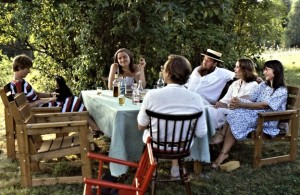
Coffee time in Lennart’s (seen from back) and Maria’s front-yard. Childhood friend Gerd, husband Göran in boater; sister Eva, Siv.
This first time in Löa for John, my old friend Ragnhild who was then still married to Lennart had incredibly delicious, homemade gravad lax (marinated salmon, as it translates, not quite correctly). Wonderful friends from Dalarna, two artists, Gerd and Göran. Gerd, one of my childhood friends that I admired the most, came down from just a few kilometers north of Löa, and they had brought the most exquisite Swedish new potatoes, homegrown of course, and dug up the same morning. We had a fabulously delicious Swedish meal and it was such a wonderful surprise that Gerd and Göran were joining us.
Well, goodbye to Sweden for this time and to particularly beautiful little town of Löa, a paradise on earth, with friends who are always ready to receive us. We would be back.
_____________________
A colleague of John’s from Collège de France, Christian, had invited us and several other people from le Collège to the summer house he rented every month of August in Anthéor on la Côte d’Azur (the Riviera for the non-French). Anthéor is situated between Cannes and Saint-Raphaël, but it is, or al least was in those days, far less expensive than the jet-set places, like Saint-Tropez or Cannes. This is actually the chic part of ‘la Côte’, but Anthéor was not on the list of luxury places. It has grown enormously though since we were there in 1971.
On our way down to la Côte, we of course drove around to a good number of see-worthy places. Trust John for sightseeing – he has it all worked out, and he knows where the most spectacular places are. From Clermond-Ferrand in le Centre we drove through the département Puy de Dôme, with its famous extinct volcano that gave its name to the department.
We drove through Auvergne, a gorgeous countryside with the most beautiful Romanesque churches, possibly in all of Europe — and Orcival probably at the top. Making statements like that is, needless to say, very risky and right away It brings to my mind the Cathedral in my beloved university town, Lund, which is a masterpiece of Romanesque art. I may also be biased if I put Lund Cathedral at the very top.
ngg_shortcode_2_placeholder” order_by=”sortorder” order_direction=”ASC” returns=”included” maximum_entity_count=”500″]
We got to the medieval town of Sarlat in Dordogne, well worth seeing. Nearby is Les Eyzies, where the remains of Cro-Magnon man were found. Just outside Les Eyzies is the Grotte de Font-de-Gaume, with the best-known prehistoric cave paintings that you can still see today. Those cave paintings are amazingly beautiful works of art, but it was far too dark inside to take pictures. No flash allowed of course.
The most famous caves for prehistoric painting, les Grottes de Lascaux are closed for tourists and what you can see today are replicas at a different site 200 meters away from the original site, but incredibly well made. The hordes of tourists who flocked to Lascaux damaged the paintings through their breathing, and the caves had to be closed.[1. By 1955, the carbon dioxide, heat, humidity, and other contaminants produced by 1,200 visitors per day had visibly damaged the paintings and introduced lichen on the walls. The cave was closed to the public in 1963 to preserve the art. (Wikipedia)]
We drove along les Gorges du Tarn where, unforgettably, Siv got ‘moist palms’ because we were driving on narrow roads at the very edge of steep cliffs.
We have been to other canyons in France since then and I do believe I am now over the kind of angoisse I felt at the time. We were driving my little Renault 4L of course and I didn’t quite know at the time what an excellent driver John is.
We went through so many places that I had or had not seen before that it’s impossible to include them all here. We went through Nîmes with its arena (les arènes de Nîmes), which I knew well and where I had even seen a corrida. What a horror!
That was not my fault. I was teaching French in a Swedish summer school in Montpellier in 1960, and the corrida was on the program. It was a fiesta in the entire town though, and quite memorable, even though I shuddered at the cruelty of the ‘spectacle’
John and I also went through Marseille and admired le vieux port, which I at least had never seen before. We then went on to Cassis, right close by to the east of Marseille for a wonderful dinner in one of the few charming fishing villages that were left on la Côte.
Someone had recommend Cassis to us, and we have been back a couple of times after that, first with John’s parents and then with my sister Gun. Cassis was at the time an adorable little town with a beautiful harbor, still unspoiled by tourism. Gun did research work on malignant melanoma one semester in Marseille and we toured the coastal part of Provence together that Easter in 1981. I remember which year because I still had a leg in a cast after a ski accident in Alpe-d’Huez.
In Anthéor, there were, besides Christian himself who had lent John and me his own bedroom, the oh-so-funny practical-joke couple Stratis, the Greek, and his wife Lucille; Marie-Gen, who worked with the bubble chamber group at the Collège de France, (Oh days long gone by) and who a couple of years later on married Pierre, an excellent physicist who is still at Collège de France, or probably retired now. They now have grown-up children, and may even be grandparents. We see them on and off whenever there is a big event at the Centre de Calcul here in Lyon, such as John’s retirement party.
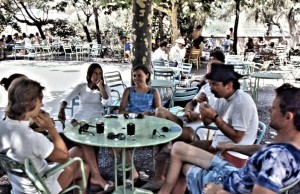
From left to right Siv, Lucille (hidden behind Siv) Claire-Jeanne, Marie-Gen, Christian (hidden), Stratis in my hat and Hans, a German friend.
And there was Claire-Jeanne, the very good arty photographer who somewhat condescendingly referred to the kind of photos John and I take as postcard pictures. There was another bachelor too, a German named Hans, whom I never got to know too well. He was a friend of Christian’s, presumably a physicist.
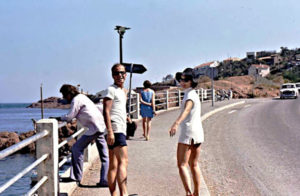
John and Siv on their way back to the house from lunch at the restaurant or a cool drink under the plane-trees.
Funny Stratis amused himself in the strangest ways. Once by throwing my black hat into the sea, never to be retrieved of course. Hilarious. Hmm. Another time he and Lucille poured water over me and I think also John as we were sitting below their bedroom window.
We took turns cooking, but more often than not we ate at a restaurant down the road, or actually up on a cliff, with a gorgeous view over the Mediterranean.
Les Flots bleus was the name of this hotel-restaurant, which became our standard eating place. It had a view over the beach and bay of Antheor, with the Mediterranean in the background.
We ate lots of seafood of course and omelette norvégienne was our favorite desert. It’s hot outside and still cold ice-cream inside. Meringue like on the outside and flambé.
John and I made a trip tp Cannes one day, mostly to do something a bit different. I had passed through it once on my way somewhere, probably when I spent a pretty boring summer in Saint-Raphaël, but Cannes is worth seeing.
The luxury is really too much though, too overwhelming, and I definitely prefer Nice which has a ‘real town’ behind the façades with la Promenade des Anglais, the exotic-looking palm trees, the blue Mediterranean and white yachts. Nice is a town where real people live, and where it’s pleasant to walk around in the shade among the old houses on a hot day, in little streets far away from the flashy waterfront.
________________________
All things come to an end and after the the summer vacation was over, I had to return to my teaching job in Westchester. John was spending another year at the Collège de France.
The year we spent on different continents we wrote frequent letters. The funny thing was that we were reading the same books, partly, and discussing Le Mythe de Sisyphe and other books by Albert Camus, the most pessimistuic author I can imagine, unless it would be Jean-Paul Sartre. Camus’ more commonly read L’Etranger is far more depressing than maybe most people realize. “Le héros absurde fait face à l’absurdité de la vie.”[1. The absurd hero faces the absurdity of life.]
In “Le Mythe de Sisyphe” Camus is introducing the expression ‘”faire le saut”. I have forgotten what exactly he means by that, but I remember being thrilled by it at the time I was reading the book. What it means to me today is making the leap from superstition, the domination of a clique of witchdoctors in whatever religion you refer to, from the land of the unseeing masses to a state of mind where you accept the absence of a mythical being to lean on. I do believe that this is also what Camus had in mind when he formed the expression “faire le saut“.
Your blinders are gone and there is nobody to go to for judgement or for advice, for comfort or for forgiveness. People will certainly react very differently if they come to this stark conclusion, but I find it a relief to know that there is no punishing or rewarding God, no salvation, no judgement. I alone am responsible for what I do and I alone can make something liveable out of my life.
The famous first sentence of “L’Etranger” sets the tone for the rest of the book. Meursault, the Stranger, says
“Aujourd’hui, maman est morte. Ou peut-être hier, je ne sais pas.” [2. “Today Mother died. Or maybe yesterday, I don’t know.”]
Just before he’s going to be executed (for having killed an Arab on the beach, without having the slightest idea why he did it – the sun was in his eyes, was all he could say), the chaplain has been seeing him and told him that he would pray for him: Meursault, the anti-hero, became furious and insulted the chaplain.
“Comme si cette grande colère m’avait purgé du mal, vidé d’espoir, devant cette nuit chargée de signes et d’étoiles, je m’ouvrais pour la première fois à la tendre indifférence du monde.”[3. “As if that blind rage had washed me clean, rid me of hope; in that night alive with signs and stars, for the first time I opened myself to the gentle indifference of the world.”]
I even read the book with an advanced French class at Mamaroneck High School in Westchester, New York, simply because they were so very eager to read it. I remember particularly discussing with the students the meaning of the last words on the very last page:
“ Pour que tout soit consommé, pour que je me sente moins seul, il me restait à souhaiter qu’il y ait beaucoup de spectateurs le jour de mon exécution et qu’ils m’accueillent avec des cris de haine.“[4. “For everything to be consummated, for me to feel less alone, I had only to wish that there be a large crowd of spectators the day of my execution and that they greet me with howls of execration.” – Translations by Esther Lombardi]
Though we never came to any conclusion, my students had many interesting interpretations.
With another class that same year we read La Symphonie Pastorale by André Gide. Also a sad book, but far less so. After finishing the book where le pasteur takes Gertrude, the young blind girl, to a concert in Neuchâtel to hear La Symphonie Pastorale, she manages to ‘see’ colors by comparing them to the various instruments. When thinking of the immense pleasure Gertrude takes in this concert, I realized that possibly most of my students had never heard this symphony, and so I wanted to have them listen to it in class. I found somewhat to my surprise that I did not have the record. So what do I do? I called up John in Paris and said ‘Listen, I want to play La Symphonie Pastorale to my students. We’ve just finished reading the book in class. Can you recommend a good recording?’ John said without a moment’s hesitation: Fritz Reiner.and the Chicago Symphony Orchestra. Fritz Reiner was already dead by then, but his music most certainly was not.
I set aside a class for the symphony and the students loved it. Most of them did indeed not know it, and it was enormously appreciated.
I have never stopped being amused, and impressed, by the way John answered without a second’s hesitation. Fritz Reiner’s recording is the one we still have today, only on a CD of course. Also I actually prefer Fritz Reiner’s interpretations of Beethoven’s symphonies in general.
_______________
John came over for Christmas and besides going to the Metropolitan Opera to see the only opera I had managed to get tickets for, “Samson and Delilah” (or Samson et Dalila as my program says) by Saint-Saëns,
After a few days we took another flight, to Florida this time, to spend Christmas with my future parents-in-law. We were exprected to arrive in Orlando a couple of days before Christmas.
I was very anxious to make a favorable impression, so I went to George Jensen in the City to buy a gorgeous platter in brushed stainless steel with a tray of teak inside to cut a roast on. I sent it ahead by mail for some reason (it was heavy, for one thing) and when we arrived they had already opened it and they were delighted. It was meant as a Christmas present, but it didn’t say so,
I met John’s entire family, except for a couple of aunts in Ohio, whom I got to know later. His sister was down from North Carolina with her first baby child, a daughter called Neall, who was less than a year old.
Grandma O’Neall may well have been my favorite. An adorable old lady who did not make a fuss about our not being married and still sharing a bedroom. The funny thing was that John’s mother went to all kids of pains to keep her from realizing the truth, but to no avail. Grandma knew that we were sharing the master bedroom, and she didn’t make a waves about it. We saw her many more times when she still lived alone in her house, also in Orlando, and later when she was in a hospital in Jacksonville where her son-in-law, Uncle Larry, a cardiologist, was her doctor.
_________________
For my Christmas present John gave me the entire recording of ‘Der Rosenkavalier’ by Richard Strauss. The entire synopsis was of course included. One Sunday, alone in my apartment in New Rochelle, I spent all day on the floor in my living room listening to the opera and reading the text by Hugo von Hofmannsthal. I found his German quite difficult to read though, and when I mentioned that years later to my very good Austrian/Parisian friend Jürgen, a former colleague from l’Ecole Centrale de Paris, he said that didn’t surprise him. Von Hofmannsthal writes a very special kind of Austrian German, probably with a lot of dialect. Fortunately the text was also in English, but I was stubborn and wanted to read it in German.
_________________
A few months later I flew over to Paris one Easter vacation by a charter flight, which I would live to regret. (When I went to London to get my flight back, in John’s company – the true gentleman – I found that the charter company no longer existed and I had to buy a regular ticket for the flight back home.)
That was most likely the time I really got to know Roberto. I remember vividly having lunch at a little restaurant across from Collège de France in rue des Ecoles, “Chez La Brune” they called it, and the people from the Collège used to eat there quite regularly. (“On se verra chez la Brune à midi.”) And that’s where Roberto really got into the picture. I was asking myself who this short, dark and quite handsome young man was who spoke with such an atrocious Spanish accent that I thought I would never learn to understand him. But things do change. As soon as we got back to Paris (I am getting ahead of my story here), Roberto became a member of the family with our dog, Puppy, and our adorable Mélisande. I soon forgot that there had ever been a time when I found Roberto difficult to understand.
Continued: Chapter 21 (Part 2) — Bergslagen and Löa 13 years later
